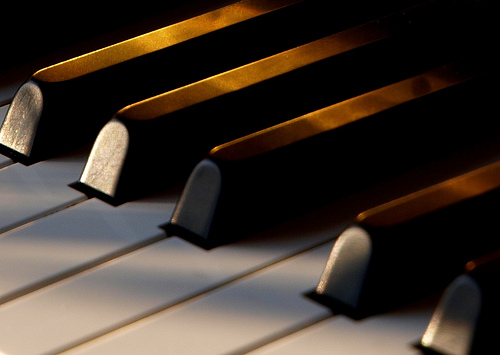While acoustic pianos are ideal in terms of touch and sound, a well-made digital keyboard is a much cheaper and more portable option. Make sure to look for a piano with a full 88 keys; most literature beyond the beginner’s level will require use of the entire keyboard. Weighted keys are also important to the development of a beginning pianist, mimicking the touch of an acoustic and strengthening the muscles in the hands. So, without further ado, here are the 4 best pianos to learn on:
Yamaha DGX-660
Yamaha brand instruments are known for their consistency, and when you’re talking about a beginning player, consistency is key to a well-developed technique. The sound of this piano is also fantastic, producing an excellent imitation of an acoustic instrument, with the full range of dynamic possibilities you would find in a string-and-hammer piano. The scaled graded hammer action in the 88 fully weighted keys gives this keyboard a feel and resonance virtually indistinguishable from an acoustic piano. The split and dual mode allow a teacher to play along with the student during lessons, while the recording and accompaniment features are very helpful for independent practice. This is one of the best digital pianos for beginners period.
Casio Privia PX 160BK
When you think of Casio, you probably think of those toy keyboards you played with as a kid. You might not know Casio makes grown up keyboards, too, with the same excellent sound and versatile features as other high-end piano makers. The ebony and ivory textured keys, along with the tri-sensor scaled hammer action, effectively emulate the acoustic playing experience. At only 25 pounds, this Casio is one of the lightest and most truly portable digital pianos with a full keyboard. The PX160 has great features for the piano student, with two separate headphone jacks on the front, so you can practice at any time without disturbing anyone—eliciting a sigh of relief from parents of budding pianists. This is easily one of the best pianos to learn on.
Kawai MP7
This Japanese company was founded in 1927 as an acoustic piano maker. Since adding digital pianos to their line, Kawai strives to give them the same quality sound as you can find in their acoustics, and with the MP7 they succeed beautifully. This keyboard has an excellent response at all dynamic levels, with weighted keys giving it a touch very similar to Kawai’s acoustic models. Unlike some digital keyboards, the cabinet on the MP7 is designed to look like an actual piano, down to the height of the keys relative to the piano’s top and the realistic response from the accompanying pedal.
Korg B1
Like the Casio, the Korg B1 sells for a very decent price. It is able to achieve such great value by simplifying its design, focusing on replicating an acoustic’s feel and tone and removing many of the bells and whistles more expensive digital pianos boast. They’ve streamlined the interface, removing the control buttons that line the tops of most digital keyboards and instead using the keys themselves as the controls. While this does take some getting used to, it can actually be better for a new player, for whom the broad array of options presented by many digital keyboards can be overwhelming. If you want to play “Hot Cross Buns” in barnyard sounds, this isn’t the piano for you. If you want to learn piano in your own home for a reasonable price, look no further than the Korg B1, one of the best beginner pianos period.
Accessories You’ll Need
If your keyboard didn’t come with a stand (see a bunch online), you’ll want to invest in one. You can play a keyboard resting on a table top in a pinch, but most household surfaces are too high to play on comfortably for long, especially for a child (or someone who, like me, a bit vertically challenged). A well-padded and adjustable piano bench (yes, a bunch here also) is also a good investment. Chairs with arms and a back will limit the player’s range of motion, and the height of the chair will doubtfully be ideal. You can find a decent piano bench for around thirty dollars online or at your local music store, and if you’ve already invested in a quality piano, it’s worth the relatively small added expense to complete your playing experience.
Setting up your piano
Good posture is integral to correct piano technique, and the height of the piano should be set with this in mind. The player’s arm should be parallel from wrist to elbow when she sits down to play. For this reason alone, a digital piano may be better to learn on than an acoustic for a younger student, because the instrument’s height can be adjusted to avoid reaching for either the keyboard or the pedals. Because a digital keyboard is going to be fairly top-heavy once placed on its stand, it’s best to set it up against a wall to prevent it from toppling and being damaged.
As I’ve said before, consistency is key for a beginning player, and so while digital pianos are highly portable it’s best to give your keyboard a designated space within your home. If possible, pick a low-traffic room with limited distractions, where the student can have sustained and uninterrupted practice time. While most digital pianos have keyboard jacks and volume controls, it’s also best to make this practice space somewhere noise won’t be an issue, so the student isn’t modifying her technique to avoid disturbing others and can still play the instrument without headphones if she chooses to.
Digital pianos are designed for use by gigging professionals, not simply for beginners, and often come with a wide range of features that can be confusing to get used to. Reading the manual is a good start to understanding everything your keyboard is capable of, but for the non-musician, the language in the manual can be as confusing as the settings themselves. If you’re working with a private instructor, ask them to give you a “tour” of your piano’s features and capabilities—not simply how to turn them on and off, but what they’re best used for. You may discover some features that will help you as you practice—and, at the very least, it’s always interesting to play around with a keyboard’s onboard rhythm tracks and sound palates. In the end, the best piano to learn on should also be fun. Good luck!








